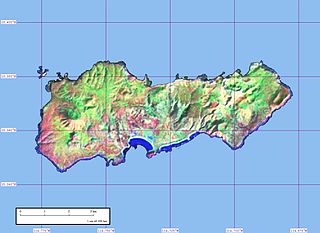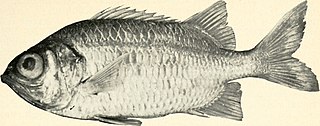
Clarion Island, formerly Santa Rosa, is the second largest, westernmost and most remote of Mexico's Revillagigedo Islands. The island is located 314 kilometres (195 mi) west of Socorro Island and over 700 kilometres (430 mi) from the Mexican mainland.

Myripristis is a genus of soldierfishes.

Myripristis vittata is a soldierfish from the Indo-Pacific.

Myripristis jacobus, the blackbar soldierfish, is a soldierfish from the Western Atlantic. It occasionally makes its way into the aquarium trade. It grows to a size of 25 cm in length.

The blotcheye soldierfish is a species of soldierfish belonging to the family Holocentridae.

Myripristis adusta, common name shadowfin soldierfish, is a species of soldierfish belonging to the family Holocentridae.

Myripristis botche, the blacktip soldierfish, splendid soldierfish, or splendid squirrelfish, is a species of soldierfish belonging to the family Holocentridae.

Myripristis kuntee is a species of fish in the family Holocentridae. It is found over a wide area the Indo-Pacific and is common in some places.

Myripristis violacea is a species of fish in the family Holocentridae found in the Indo-Pacific Ocean
Myripristis amaena is a species of fish in the family Holocentridae found in the Pacific Ocean. Their range spans from Indonesia and the Philippines, Hawaii and Ducie Island, north to Ryukyu and Minami-Tori-shima, and south to Micronesia. They are reef fish, often inhabiting caves and rock ledges.

Myripristis leiognathus is a species of fish in the family Holocentridae found in the eastern Pacific Ocean. Their range spans from the Gulf of California to the coast of Ecuador, and outwards to the Galapagos, the Revillagigedo Islands, and Cocos Island. They are reef fish, often found hiding out at caves and rock ledges during the day and feeding on crustaceans at night. They are occasionally fished for, and sold by fishmongers.

Myripristis chryseres, the yellowfin soldierfish, is a nocturnal species of soldierfish from the genus Myripristis. It is found in the Indo-Pacific region, from Natal, South Africa to Samoa, Hawaii and the Tuamotu Islands, north to south Japan and the Ogasawara Islands, and south to Queensland, Australia It inhabits steep outer reef slopes and is often seen with Coelacanths at Ngazidja Island. It feeds on zooplankton and can be seen either solitary or in groups.

Myripristis gildi, also known as the Clipperton cardinal soldierfish, is a species of soldierfish belonging to the genus Myripristis. First described in 1965 by Greenfield, it is endemic to Clipperton Island in the Eastern Pacific Ocean. Its total length reaches at least 21.4cm.
Myripristis greenfieldi is a species of soldierfish belonging to the genus Myripristis. It is believed to be endemic to Japan, the Ogasawara islands and the Ryukyu Islands in the North-western Pacific Ocean. It is named after ichthyologist David Wayne Greenfield. It is demersal.

Myripristis hexagona, the doubletooth soldierfish, is a nocturnal species of soldierfish from the genus Myripristis. It is light red to yellowish in colour, and grows to a maximum length of 30 cm. It can be found in the Indo-Pacific region, from East Africa to Samoa, north to the Ryukyu Islands, Japan, and south to the Great Barrier Reef and New Caledonia. However, it has not been found on low islands or atolls in the Indo-Pacific region. It is found at depths of 3–40 metres and inhabits sheltered coastal and offshore reefs, typically in turbid areas of bays or lagoons. During the day, it hides in caves or beneath ledges, while at night, it feeds on plankton. It can be found in loose aggregations, sometimes with other species of soldierfish.

Myripristis pralinia, the scarlet soldierfish, is a nocturnal species of soldierfish from the genus Myripristis. It can be found in the Indo-Pacific region, from East Africa to the Marquesas Islands and the Gambier Islands, north to the Ryukyu Islands and south to New Caledonia. It can also be found on the Marshall Islands and the Mariana Islands. It can be found in small, loose groups in caves or under ledges in reef flats, lagoons and outer reef slopes. It feeds on plankton.
Myripristis tiki, the tiki squirrelfish, is a species of soldierfish belonging to the genus Myripristis. It can be found in the Pacific Ocean in the Cook Islands, Tonga, Pitcairn, the Cook Islands and Easter Island.
Myripristis trachyacron, the East Indian soldierfish, is a small, rare, poorly-understood species of soldierfish belonging to the genus Myripristis. It can be found in the Western Pacific Ocean in Indonesia, Philippines, Papua New Guinea and the Solomon Islands. It swims in small aggregations in current prone channels, at moderate slopes. It inhabits outer reef slopes. This species is easily mistaken for Myripristis vittata.
Myripristis woodsi, the whitespot soldierfish, is a species of soldierfish belonging to the genus Myripristis. It is found in the Pacific Ocean, in all of Oceania except Hawaii, the Solomon Islands, New Caledonia, the Caroline Islands, the Line Islands, and north to the Bonin Islands and Marcus Island and south to Samoa and the Tuamoto Islands. It inhabits reef flats, lagoons and seaward reefs. It can be commonly found on exposed outer-reef areas, often at low islands or atolls. It feeds on zooplankton. It is named in honour of ichthyologist Loren Paul Woods.
Urosaurus clarionensis is a species of lizard. The common name for this species is the Clarion Island tree lizard. Its range includes Clarion Island in Baja California.














